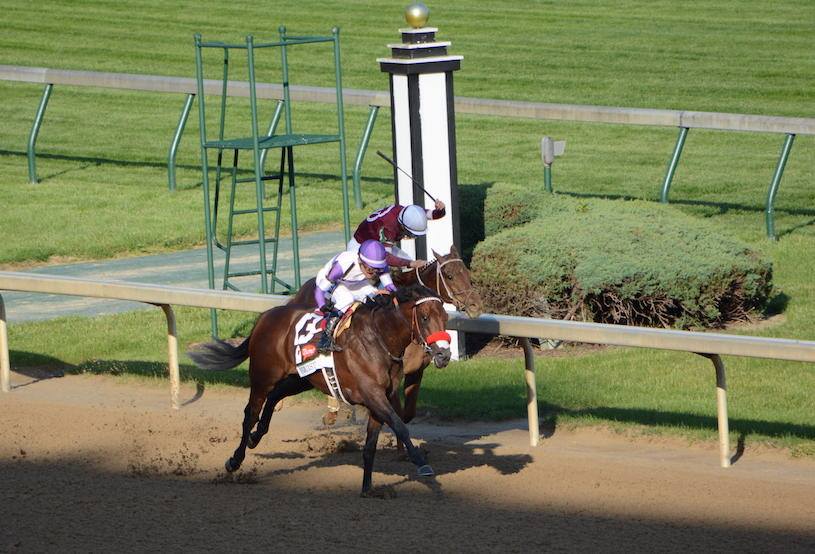As we begin contemplating the second jewel of thoroughbred racing’s Triple Crown, your first question probably is, “What is a Preakness?” That is a very good question because some people in Baltimore think it has something to do with the Colts moving to Indianapolis and that simply is not true.
You will not be surprised to learn that “Preakness” is a Native American word that means “Woods of the quail.” Or something like that. It also was the name of the horse that won the featured stakes on May 27, 1873, the first day the Pimlico race track outside Baltimore was open for business.
Gov. Oden Bowie, a Democrat, is given the credit both for building Pimlico and starting the Preakness. By the way, in case you were wondering, the name Pimlico dates back to the 1660s, when Old Ben Pimlico’s Tavern was a popular watering hole in London.

Today Pimlico is, well, a dump. There’s no other way to put it. When you read that Pimlico is being renovated, it means they’re slapping another coat of paint on the dilapidated grandstand.
The neighborhood around Pimlico is not one in which you would want to take a leisurely stroll after dark. It’s the sort of neighborhood where every time Baltimore has a riot, the Pimlico area is certain to be the site of burning, looting, and general, all-around vandalism.
Pimlico’s partners in the Triple Crown, Churchill Downs in Louisville and Belmont Park on Long Island, have kept up with the times and offer a satisfactory racing experience for those who can afford it. But Pimlico just hasn’t kept up. It looks more or less the same today as it did back in November of 1938, when Seabiscuit defeated 1937 Triple Crown winner War Admiral in their ballyhooed match race.
Churchill and Belmont have tried a variety of means, including pleading and begging, to coerce Pimlico to make improvements. They have even threatened to kick the Preakness out of the Triple Crown. But so far nothing has worked. Even after the Stronach Group bought the track in 2010, Pimlico has remained an eyesore.
This is a shame because, otherwise, Baltimore is an interesting city and Preakness week always is a lot of fun for visiting horsemen, media, and racing fans. There is an abundance of quaint taverns and restaurants where tourists can learn to crack and eat the crabs for which the city is famous.
Despite the track’s liabilities, the Preakness always draws the second biggest crowd of any race in North America, trailing only the Derby. The Kentucky Oaks, held the Friday before the Derby, is creeping up on the Preakness. This year the Oaks drew a record 124,000 and change. The Preakness usually gets something in the 130,000 range.
The Preakness is the quirkiest of the Triple Crown races, if for no other reason than it’s run at a mile and 3/16ths. That is a 16th of a mile shorter than the Derby and 5/16ths shorter than the mile-and-a-half Belmont Stakes. It defies logic, but, then, so does calling the Preakness “The Run for the Black-Eyed Susans” when Maryland’s state flower doesn’t bloom until six weeks or so after the race.
For many years, Pimlico adorned the winner of the Preakness with fake Black-Eyed Susans. They took daisies and applied shoe polish to the center to make them look like Black-Eyed Susans. But this fraud was stopped at the turn of the century, and today the Preakness winner gets a blanket of Viking poms, whatever they are.
Sometimes the Preakness is nothing more than a rubber stamp for the Derby winner. Other times, it provides redemption for a great horse who got beat in the Derby because of traffic problems. And still other times, a Maryland-based horse known as the “house horse” is lying in wait to ruin the Derby winner’s Triple Crown dreams.
It’s always good for the sport when the Derby winner adds the Preakness because that sets up the possibility of a Triple Crown winner, which has become the most coveted achievement in the sport. Last year American Pharoah became the first colt since Affirmed in 1978 to sweep the three races, and his successful quest generated tons of badly need positive publicity for the sport.
The Triple Crown wasn’t recognized as such until the 1930s, when writer Charlie Hatton of The Daily Racing Form coined the phrase. Retroactively, Sir Barton in 1919 was recognized as the first Triple Crown winner. The other 11 are Gallant Fox (1930), Omaha (1935), War Admiral (1937), Whirlaway (1941) Count Fleet (1943), Assault (1946), Citation (1948), Secretariat (1973), Seattle Slew (1977), Affirmed (1978), and American Pharoah.
Now comes Nyquist, bidding to become the second horse to win the Triple Crown while still unbeaten (Slew was the other).
Nyquist is 8-for-8 in his career and that’s all that’s important. The handicapping experts can try all the want to make a case for one of his challengers in the Preakness on May 21, but until somebody proves he can be beaten, it’s really an exercise in futility to pick against him.
He has the same connections (owner John Paul Reddam, trainer Doug O’Neill, and jockey Mario Gutierrez) who won the 2012 Derby and Preakness with I’ll Have Another. That colt seemed poise to win the Triple Crown, until he was diagnosed with a tendonitis the day before the Belmont.
He probably could have run despite the injury, but Reddam and O’Neill did the right thing by scratching him, even if it sorely disappointed the bettors and the NBC network.
I’ll Have Another won the Preakness by overtaking Bodemeister in the final strides. That was a huge disappointment for Bodemeister’s trainer, Bob Baffert, who had named his colt after his son Bode. Of course, the racing gods more than made it up to Baffert last year by letting him train American Pharoah.
At this point Nyquist, named for a professional hockey player, has accomplished more than American Pharoah, who was not unbeaten when he won the Derby. In addition, Nyquist’s winning Derby time was faster than the Pharoah. By any reckoning, he has a license to give racing only its second back-to-back Triple Crown winners (Slew in ’77 and Affirmed in ’78 were the others).
Yet nothing can be taken for granted at Pimlico, except the conditions of the facility. I’m not sure if the Native Americans had a word for “dump,” but if they did, that’s what Pimlico should be called.
Billy Reed is a member of the U.S. Basketball Writers Hall of Fame, the Kentucky Journalism Hall of Fame, the Kentucky Athletic Hall of Fame and the Transylvania University Hall of Fame. He has been named Kentucky Sports Writer of the Year eight times and has won the Eclipse Award twice. Reed has written about a multitude of sports events for over four decades, but he is perhaps one of media’s most knowledgeable writers on the Kentucky Derby























You hit it right on the head–a dump- why it hasn’t been taken away is beyond my wildest imagination, but it is what it is ! I’ve been a pony gambler since 72 and went to Pimlico during the 70’s and early 80’s for the Preakness, but haven’t been back since because of your true statements.